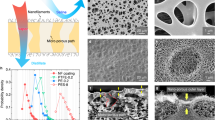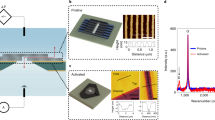Abstract
Water shortages and brine waste management are increasing challenges for coastal and inland regions, with high-salinity brines presenting a particularly challenging problem. These high-salinity waters require the use of thermally driven treatment processes, such as membrane distillation, which suffer from high complexity and cost. Here, we demonstrate how controlling the frequency of an applied alternating current at high potentials (20 Vpp) to a porous thin-film carbon nanotube (CNT)/polymer composite Joule heating element can prevent CNT degradation in ionizable environments such as high-salinity brines. By operating at sufficiently high frequencies, these porous thin-films can be directly immersed in highly ionizable environments and used as flow-through heating elements. We demonstrate that porous CNT/polymer composites can be used as self-heating membranes to directly heat high-salinity brines at the water/vapour interface of the membrane distillation element, achieving high single-pass recoveries that approach 100%, far exceeding standard membrane distillation recovery limits.
This is a preview of subscription content, access via your institution
Access options
Access Nature and 54 other Nature Portfolio journals
Get Nature+, our best-value online-access subscription
$29.99 / 30 days
cancel any time
Subscribe to this journal
Receive 12 print issues and online access
$259.00 per year
only $21.58 per issue
Buy this article
- Purchase on Springer Link
- Instant access to full article PDF
Prices may be subject to local taxes which are calculated during checkout




Similar content being viewed by others
References
Shannon, M. A. et al. Science and technology for water purification in the coming decades. Nature 452, 301–310 (2008).
Elimelech, M. & Phillip, W. A. The future of seawater desalination: energy, technology, and the environment. Science 333, 712–717 (2011).
Fritzmann, C., Löwenberg, J., Wintgens, T. & Melin, T. State-of-the-art of reverse osmosis desalination. Desalination 216, 1–76 (2007).
Eykens, L. et al. Influence of membrane thickness and process conditions on direct contact membrane distillation at different salinities. J. Membr. Sci. 498, 353–364 (2016).
Alkhudhiri, A., Darwish, N. & Hilal, N. Membrane distillation: a comprehensive review. Desalination 287, 2–18 (2012).
Mundhenk, N., Huttenloch, P., Kohl, T., Steger, H. & Zorn, R. Metal corrosion in geothermal brine environments of the Upper Rhine graben – laboratory and on-site studies. Geothermics 46, 14–21 (2013).
Jang, H.-S., Jeon, S. K. & Nahm, S. H. The manufacture of a transparent film heater by spinning multi-walled carbon nanotubes. Carbon 49, 111–116 (2011).
Janas, D. & Koziol, K. K. Rapid electrothermal response of high-temperature carbon nanotube film heaters. Carbon 59, 457–463 (2013).
Wu, Z. P. & Wang, J. N. Preparation of large-area double-walled carbon nanotube films and application as film heater. Physica E 42, 77–81 (2009).
Jung, D., Kim, D., Lee, K. H., Overzet, L. J. & Lee, G. S. Transparent film heaters using multi-walled carbon nanotube sheets. Sens. Actuat. Phys. 199, 176–180 (2013).
Gupta, R., Rao, K. D. M., Kiruthika, S. & Kulkarni, G. U. Visibly transparent heaters. ACS Appl. Mater. Interfaces 8, 12559–12575 (2016).
Kang, T. J., Kim, T., Seo, S. M., Park, Y. J. & Kim, Y. H. Thickness-dependent thermal resistance of a transparent glass heater with a single-walled carbon nanotube coating. Carbon 49, 1087–1093 (2011).
Jyoti, G., Keshav, A. & Anandkumar, J. Review on pervaporation: theory, membrane performance, and application to intensification of esterification reaction. J. Eng. 2015, 1–24 (2015).
Ong, Y. K. et al. Recent membrane development for pervaporation processes. Prog. Polym. Sci. 57, 1–31 (2016).
Saeidi, S., Amin, N. A. S. & Rahimpour, M. R. Hydrogenation of CO2 to value-added products—a review and potential future developments. J. CO2 Util. 5, 66–81 (2014).
Jadhav, S. G., Vaidya, P. D., Bhanage, B. M. & Joshi, J. B. Catalytic carbon dioxide hydrogenation to methanol: a review of recent studies. Chem. Eng. Res. Des. 92, 2557–2567 (2014).
Honig, R. E. Ionization potentials of some hydrocarbon series. J. Chem. Phys. 16, 105–112 (1948).
Parker, V. D. Energetics of electrode reactions. II. The relationship between redox potentials, ionization potentials, electron affinities, and solvation energies of aromatic hydrocarbons. J. Am. Chem. Soc. 98, 98–103 (1976).
Liu, P., Liu, L., Jiang, K. & Fan, S. Carbon-nanotube-film microheater on a polyethylene terephthalate substrate and its application in thermochromic displays. Small 7, 732–736 (2011).
Zhang, Q., Huang, J.-Q., Qian, W.-Z., Zhang, Y.-Y. & Wei, F. The road for nanomaterials industry: a review of carbon nanotube production, post-treatment, and bulk applications for composites and energy storage. Small 9, 1237–1265 (2013).
Dudchenko, A. V., Rolf, J., Russell, K., Duan, W. & Jassby, D. Organic fouling inhibition on electrically conducting carbon nanotube–polyvinyl alcohol composite ultrafiltration membranes. J. Membr. Sci. 468, 1–10 (2014).
de Lannoy, C., Jassby, D., Davis, D. D. & Wiesner, M. R. A highly electrically conductive polymer–multiwalled carbon nanotube nanocomposite membrane. J. Membr. Sci. 415–416, 718–724 (2012).
Duan, W., Ronen, A., Walker, S. & Jassby, D. Polyaniline-coated carbon nanotube ultrafiltration membranes: enhanced anodic stability for in situ cleaning and electro-oxidation processes. ACS Appl. Mater. Interfaces 8, 22574–22584 (2016).
Liu, H., Vajpayee, A. & Vecitis, C. D. Bismuth-doped tin oxide-coated carbon nanotube network: improved anode stability and efficiency for flow-through organic electrooxidation. ACS Appl. Mater. Interfaces 5, 10054–10066 (2013).
Janas, D., Kreft, S. K., Boncel, S. & Koziol, K. K. K. Durability and surface chemistry of horizontally aligned CNT films as electrodes upon electrolysis of acidic aqueous solution. J. Mater. Sci. 49, 7231–7243 (2014).
Bagotsky, V. S. Fundamentals of Electrochemistry (John Wiley & Sons, 2005).
Weber, B. et al. Ohm's law survives to the atomic scale. Science 335, 64–67 (2012).
Verwey, E. & Overbeek, T. Theory of Stabilty of Lyophobic Colloids (Elsievier, 1948).
Kilic, M. S., Bazant, M. Z. & Ajdari, A. Steric effects in the dynamics of electrolytes at large applied voltages. II. Modified Poisson-Nernst-Planck equations. Phys. Rev. E 75, 021503 (2007).
Barsoukov, E. & Ross Macdonald, J. (eds) Impedance Spectroscopy: Theory, Experiment, and Applications (Wiley-Interscience, 2005).
Ayliffe, H. E., Frazier, A. B. & Rabbitt, R. D. Electric impedance spectroscopy using microchannels with integrated metal electrodes. J. Microelectromech. Syst. 8, 50–57 (1999).
Randles, J. E. B. Kinetics of rapid electrode reactions. Discuss. Faraday Soc. 1, 11–19 (1947).
Lin, S., Yip, N. Y. & Elimelech, M. Direct contact membrane distillation with heat recovery: thermodynamic insights from module scale modeling. J. Membr. Sci. 453, 498–515 (2014).
He, F., Gilron, J. & Sirkar, K. K. High water recovery in direct contact membrane distillation using a series of cascades. Desalination 323, 48–54 (2013).
Baloch, K. H., Voskanian, N., Bronsgeest, M. & Cumings, J. Remote Joule heating by a carbon nanotube. Nat. Nanotech. 7, 316–319 (2012).
Kaatze, U. Complex permittivity of water as a function of frequency and temperature. J. Chem. Eng. Data 34, 371–374 (1989).
Zuo, G., Wang, R., Field, R. & Fane, A. G. Energy efficiency evaluation and economic analyses of direct contact membrane distillation system using Aspen Plus. Desalination 283, 237–244 (2011).
Saffarini, R. B., Summers, E. K., Arafat, H. A. & Lienhard V, J. H. Technical evaluation of stand-alone solar powered membrane distillation systems. Desalination 286, 332–341 (2012).
Summers, E. K., Arafat, H. A. & Lienhard, J. H. Energy efficiency comparison of single-stage membrane distillation (MD) desalination cycles in different configurations. Desalination 290, 54–66 (2012).
Criscuoli, A., Carnevale, M. C. & Drioli, E. Evaluation of energy requirements in membrane distillation. Chem. Eng. Process. Process Intensif. 47, 1098–1105 (2008).
Guillén-Burrieza, E. et al. Experimental analysis of an air gap membrane distillation solar desalination pilot system. J. Membr. Sci. 379, 386–396 (2011).
Winter, D., Koschikowski, J. & Wieghaus, M. Desalination using membrane distillation: experimental studies on full scale spiral wound modules. J. Membr. Sci. 375, 104–112 (2011).
Gingerich, D. B. & Mauter, M. S. Quantity, quality, and availability of waste heat from United States thermal power generation. Environ. Sci. Technol. 49, 8297–8306 (2015).
Logg, A., Mardal, K.-A. & Wells G. N. (eds) Automated Solution of Differential Equations by the Finite Element Method (Lecture Notes in Computational Science and Engineering 84, Springer, 2012).
Lackovic, I., Magjarevic, R. & Miklavcic, D. Three-dimensional finite-element analysis of Joule heating in electrochemotherapy and in vivo gene electrotransfer. IEEE Trans. Dielectr. Electr. Insul. 16, 1338–1347 (2009).
Girault, V. & Raviart, P.-A. Finite Element Methods for Navier-Stokes Equations: Theory and Algorithms (Springer, 1986).
Sharqawy, M. H., Lienhard, J. H. & Zubair, S. M. Thermophysical properties of seawater: a review of existing correlations and data. Desalination Water Treat. 16, 354–380 (2010).
Acknowledgements
We appreciate the funding from the Integrative Graduate Education and Research Traineeship: water sense—water social, engineering, and natural sciences engagement program (award abstract no. 1144635), ACS Petroleum Research Fund (54649-dni9), and the Office of Naval Research (n00014-14-1-0809). In addition, this work was undertaken in collaboration with the US Department of Energy's National Renewable Energy Laboratory (NREL) with funding under subcontract XEU-6-62543-01 and prime contract DE-AC36-08GO28308.
Author information
Authors and Affiliations
Contributions
D.J. and A.V.D. conceived the idea, designed the experiments and wrote the manuscript. A.V.D. performed experiments, data analysis, EIS fitting and FEM simulations. C.C., A.C. and J.R. assisted in material synthesis and characterization.
Corresponding author
Ethics declarations
Competing interests
The authors declare no competing financial interests.
Supplementary information
Supplementary information
Supplementary Information (PDF 892 kb)
Rights and permissions
About this article
Cite this article
Dudchenko, A., Chen, C., Cardenas, A. et al. Frequency-dependent stability of CNT Joule heaters in ionizable media and desalination processes. Nature Nanotech 12, 557–563 (2017). https://doi.org/10.1038/nnano.2017.102
Received:
Accepted:
Published:
Issue Date:
DOI: https://doi.org/10.1038/nnano.2017.102
This article is cited by
-
Mitigation of Thermal Energy in Membrane Distillation for Environmental Sustainability
Current Pollution Reports (2023)
-
Plant-leaf-inspired MXene-silk composite for intelligent solar steam generation combined with mechanical actuation
Nano Research (2023)
-
A review of membrane distillation enhancement via thermal management and molecular transport through nanomaterial-based membranes
Science China Technological Sciences (2023)
-
Transforming Ti3C2Tx MXene’s intrinsic hydrophilicity into superhydrophobicity for efficient photothermal membrane desalination
Nature Communications (2022)
-
Oil-polluted water purification via the carbon-nanotubes-doped organohydrogel platform
Nano Research (2022)



